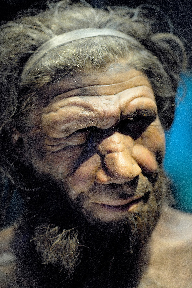A study on Neanderthal cuisine that sums up twenty years of archaeological excavations at the cave Gruta da Oliveira (Portugal), comes to a striking conclusion: Neanderthals were as intelligent as Homo sapiens.
 Neanderthals did not belong to a different species but were actually another form of human, a 20-year study has concluded. Although portrayed as a more primitive version of us, scientists say that they were as intelligent as we are, had symbolic thought, could create artistic objects, had an extremely varied diet and used fire to cook.
Neanderthals did not belong to a different species but were actually another form of human, a 20-year study has concluded. Although portrayed as a more primitive version of us, scientists say that they were as intelligent as we are, had symbolic thought, could create artistic objects, had an extremely varied diet and used fire to cook.
Dr Diego Angelucci, archaeologist at the University of Trento and co-author of the study said: “More than different species, I would speak of different human forms. “We found no difference: they lived in the caves in similar ways. Their skills are also a sign of intelligence. “They did not belong to different species, I would say that they were different human forms.”
The team made their reassessment after an analysis of the findings from the Gruta de Oliveira in central Portugal, on excavations from 1989 to 2012.
It is one of the most important European archaeological sites for the Middle Palaeolithic. The cave is part of the Almonda karst system, a vast network of caves placed at different elevations above a large spring that has been inhabited in different periods during prehistory.
The oldest layers of the Gruta de Oliveira, which includes a number of passages, date back to about 120,000 years ago, the most recent to about 40,000.
It is believed that Neanderthals inhabited this place between 100,000 and 70,000 years ago. The researchers compared the remains of structured fires found in the same location. Archaeologists found traces of about a dozen hearths intentionally built and used in the cave in an excavation area of about 30 square meters and six meters deep. The unmistakable basin-like, circular structures were filled with remains. Findings from inside and near the hearths demonstrate that the inhabitants of the caves used to cook their food.
Dr Angelucci added: “We found burnt bones, burnt wood and ash remains. And the rock underneath has been reddened by the heat. This is a crucial detail because it tells us that the structure is in a primary position. And it has always been there.
However, they could not find out how they started fire, with Dr Angelucci saying: “Perhaps they did as in Neolithic times, striking flint rocks against another rock to throw sparks on a tinder, such as a dry nest for example. “This is a prehistoric technique that was discovered by studying Ötzi, the Ice man. So far, however, we have found no evidence of this.
“Neanderthals were capable of symbolic thought, could create artistic objects, knew how to decorate their bodies using personal ornaments and had an extremely varied diet. Add to that that, based on our findings, we can say with certainty that they habitually ate cooked food. This ability confirms that they were as skilled as the Homo sapiens who lived millennia later.”The study
This article represents the end of a long data analysis work that examined 30 years of findings. The Portuguese team of João Zilhão studied the stone tools, while Mariana Nabais analyzed the bone remains and conducted spatial analyses to examine the position of the finds in the cave and the location of the fires.
The research group of the University of Trento (Department of Humanities) focused on stratigraphy and microscopic studies. “We relied on the techniques of interdisciplinary archaeology: preliminary on site studies, meticulous excavation, accurate positioning of all the finds, systematic sieving, the precise method of collecting data in the field, the collection of samples for subsequent analysis under the microscope or in the laboratory: this type of archaeology is carried out with the most advanced methodologies.
The study was published in the journal PLOS ONE.
Photo Credit:
